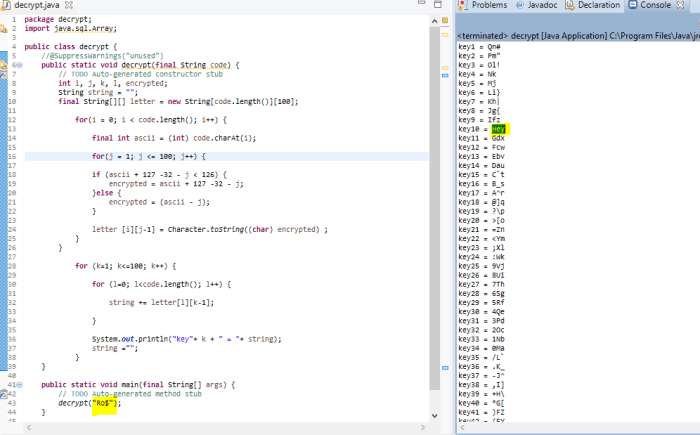Java an introduction to problem solving and programming 8th edition – Java: An Introduction to Problem Solving and Programming, 8th Edition, by Walter Savitch, offers a comprehensive and engaging introduction to Java programming. This updated edition seamlessly integrates problem-solving techniques and programming concepts, providing readers with a solid foundation for success in Java programming.
Through clear and concise explanations, real-world examples, and a focus on problem-solving, this book empowers readers to develop their programming skills and apply them to a wide range of applications.
1. Overview of Java
An Introduction to Problem Solving and Programming, 8th Edition
The book “Java: An Introduction to Problem Solving and Programming, 8th Edition” is a comprehensive guide to the Java programming language, designed for beginners and students with little to no prior programming experience.
It aims to teach the fundamental concepts of Java, problem-solving techniques, and programming principles.
The book’s target audience includes aspiring programmers, computer science students, and individuals seeking to develop their Java skills for various applications, such as web development, mobile development, and data science.
Brief History and Evolution of Java
Java was developed by Sun Microsystems in the early 1990s as a platform-independent programming language. Its initial release in 1995 revolutionized software development due to its “write once, run anywhere” principle, which allowed Java programs to run on different operating systems without the need for recompilation.
Over the years, Java has evolved significantly, with new features and enhancements being introduced in subsequent versions. Today, Java remains one of the most popular and widely used programming languages worldwide, with a vast ecosystem of libraries, frameworks, and tools.
2. Core Concepts of Java Programming
Java is an object-oriented programming (OOP) language, which means that it emphasizes the use of objects and classes to represent real-world entities and their relationships.
Fundamental Concepts
- Variables:Containers that store data and can be assigned different values during program execution.
- Data Types:Define the type of data that a variable can hold, such as integers, floating-point numbers, and characters.
- Operators:Symbols used to perform mathematical, logical, and relational operations on data.
- Control Flow:Statements that control the execution flow of a program, such as if-else statements, loops, and switch statements.
Object-Oriented Programming (OOP) in Java
- Classes:Blueprints that define the structure and behavior of objects.
- Objects:Instances of classes that represent real-world entities and have their own state and behavior.
- Inheritance:The ability for subclasses to inherit properties and methods from their parent classes.
- Polymorphism:The ability for objects of different classes to respond to the same message in different ways.
3. Problem-Solving Techniques and Algorithms: Java An Introduction To Problem Solving And Programming 8th Edition
Problem-solving is a fundamental aspect of programming, and Java provides a range of tools and techniques to facilitate this process.
Problem-Solving Strategies
- Divide and Conquer:Breaking down a large problem into smaller, manageable subproblems.
- Recursion:Solving a problem by repeatedly calling a function with a modified version of the original problem.
- Dynamic Programming:Storing the results of subproblems to avoid recomputation.
Algorithms
Algorithms are step-by-step instructions that solve specific problems. In Java, algorithms can be implemented using methods and loops.
Common Algorithms, Java an introduction to problem solving and programming 8th edition
- Sorting Algorithms:Algorithms that arrange data in a specific order, such as quicksort and merge sort.
- Searching Algorithms:Algorithms that find a specific element within a data structure, such as linear search and binary search.
- Graph Algorithms:Algorithms that solve problems related to graphs, such as finding the shortest path or detecting cycles.
4. Data Structures and Collections

Data structures are used to organize and store data in a way that facilitates efficient access and manipulation.
Common Data Structures
- Arrays:Fixed-size collections of elements of the same type.
- Lists:Dynamically sized collections of elements that can be accessed and modified.
- Stacks:Collections that follow the last-in-first-out (LIFO) principle.
- Queues:Collections that follow the first-in-first-out (FIFO) principle.
Advantages and Disadvantages
Different data structures have their own advantages and disadvantages, and the choice of which data structure to use depends on the specific requirements of the problem.
Implementing Data Structures in Java
Java provides a range of classes and interfaces for implementing common data structures, such as ArrayList, LinkedList, and HashMap.
5. Exception Handling and Error Management

Exception handling is a crucial aspect of Java programming that allows programmers to handle errors and exceptions that may occur during program execution.
Importance of Exception Handling
Exception handling helps to ensure that programs are robust and can recover from errors gracefully, preventing program crashes and data loss.
Types of Exceptions
Java has a wide range of built-in exceptions, such as NullPointerException, ArrayIndexOutOfBoundsException, and IOException, that can be thrown when errors occur.
Handling Exceptions
Exceptions can be handled using try-catch blocks, which allow programmers to specify actions to be taken when specific exceptions occur.
FAQ Compilation
What is the target audience for this book?
This book is designed for students and programmers with little to no prior programming experience who want to learn Java.
What are the key features of this book?
Key features include its problem-solving focus, real-world examples, and comprehensive coverage of Java fundamentals.
What are the benefits of using Java?
Java is a versatile and widely-used programming language that is known for its portability, security, and object-oriented approach.

